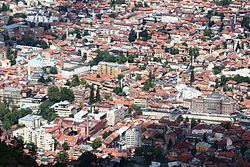Area code(s) +387 33 Team HK Stari Grad | Time zone CET (UTC+1) Local time Sunday 11:07 AM | |
 | ||
Weather 7°C, Wind W at 3 km/h, 85% Humidity Points of interest Baščaršija, Gazi Husrev‑beg Mosque, Serbian Orthodox Cathedral, Svrzo's House, Museum of Sarajevo 1878–1918 | ||
Pansion stari grad sarajevo bosnia and herzegovina hd review
Stari Grad ([stâːriː grâːd]; English: Old Town) is a municipality in Sarajevo, Bosnia and Herzegovina. It is the oldest and most historically significant part of Sarajevo. At its heart is the Baščaršija, the old town market sector where the city was founded by the Ottoman general Isa-Beg Isaković in the 15th century.
Contents
- Pansion stari grad sarajevo bosnia and herzegovina hd review
- Map of Stari Grad Sarajevo Bosnia and Herzegovina
- Features
- 1971
- 1991
- 2013
- Sites
- References
Map of Stari Grad Sarajevo, Bosnia and Herzegovina
Features
The municipality of Stari Grad is characterized by its many religious structures, and examples of unique Bosnian architecture. The eastern half of Stari Grad consists of the Ottoman influenced sectors of the city, while the western half showcases an architecture and culture that arrived with Austria-Hungary, symbolically representing the city as a meeting place between East and West.
The population of Stari Grad is slightly above 50,000, making it the least populous of Sarajevo's four municipalities. Its population density of 742.5 inhabitants per km² also ranks it last among four. Stari Grad contains numerous hotels and tourist attractions including the Gazi Husrev-beg's Mosque, Careva Džamija, and the Sarajevo Cathedral.
1971
126,598 total
1991
50,744 total
2013
36,976 total
Sites
Prior to 1914, the Austro-Hungarians who ruled Sarajevo wanted land in the Sarajevo Old Town district to build a city hall and library. The land had a home on it and, despite offering the owner money, he refused and continued to refuse even when told that he had to move. When the officials threatened him, he moved the house and rebuilt it, piece by piece, on the other side of the Miljacka river, as a way of spiting the officials. The Sarajevo spite house operates today as a restaurant is called "Inat Kuća" which means "Spite House."
